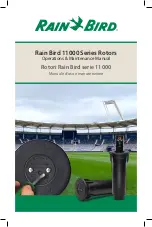
3
Design Requirements—Standard Applications
The Model GB or GB-QR Dry Pendent Sprinklers are intended for stan-
dard area coverages and standard flow and pressure requirements as
specified in current NFPA Standards.
Design
Data
All Model GB and GB-QR Dry
Pendent Automatic Sprinklers must
be installed according to current
NFPA 13 Standards. Deviations from
these requirements and standards or
any alteration to the sprinkler itself
will void any warranty made by
Central Sprinkler Company. In
addition, installation must also meet
local government provisions, codes
and standards as applicable.
Dry pendent sprinklers are
designed to prevent water from
accumulating in drops to sprinklers.
To accomplish this, they have a fitting
that protrudes into the branch line
that allows the plug to sit above the
water line, if there is any residual
water, and operate without the
potential of freezing. Always install
dry sprinklers in a threaded tee.
Check for the proper model, style,
orifice size, and temperature rating
prior to installation. Install sprinklers
after the piping is in place to avoid
mechanical damage; replace any
damaged units.
Upon completion of the installation,
the system must be tested per
recognized standards.
In the event of a thread leak,
remove the unit, apply new pipe joint
compound or tape, and reinstall.
Installation Sequence
Step 1.
The unit must be installed
into a threaded, cast iron, ductile
iron, or malleable iron tee only. It
may be installed into the run or
outlet of this tee. Do not install
into an elbow or mechanical tee.
Step 2. Use only a non-hardening
pipe joint compound or Teflon* tape.
Apply only to the male threads.
*Teflon is a trademark of the DuPont Corp.
Step 3. Hand tighten the sprinkler
into the fitting. Use the appropriate
Central Sprinkler Wrench to tighten
the unit in the fitting. A leak tight joint
requires only 7 to 14 ft. lbs. (9.5 to
19.0 Nm) of torque; a tangential force
of 14 to 28 lbs. (62.3 to 124.5 N)
delivered through a 6" (150 mm)
handle will deliver adequate torque.
Torque levels over 40 ft. lbs. (54.4
Nm) may twist the head in the main
tube, damaging the seal. The Model
GB Dry Pendent can be installed by
using the correct wrench on either the
sprinkler wrench boss or the barrel of
the dry pendent.
Step 4. To install the escutcheon
plate, align it with and push it over the
sprinkler body and into the upper
support piece until the outer edge of
the escutcheon meets the mounting
surface. The recessed escutcheon
tool may be used to install the
escutcheon plate easily from the floor.
Do not over- or under-tighten the
sprinkler to compensate for
inaccurate escutcheon plate
adjustment.
Caution: If installing in a CPVC
system, appropriate adaptation must
be made to insure that the dry pen-
dent is being installed into a threaded,
cast iron, ductile iron, or malleable iron
tee only. Special care must be taken
when installing with a CPVC system.
Sprinklers must be installed after the
manufacturer's recommended setting
time for the primer and cement to
ensure that neither accumulate within
the sprinkler.
Special care must be taken when
installing with a copper system.
Sprinklers must be installed only after
the inside of the sprinkler drop and
associated fittings have been wire
brushed to remove any flux. Residual
flux can cause corrosion and in
extreme cases can impair proper
sprinkler operation.
Care &
Maintenance
Sprinklers must be handled care-
fully. They must not be transported
or stored where ambient temperature
may exceed 100
°
F/38
°
C. For best
results, store them in a dry, cool
location in the original shipping
package.
Do not install sprinklers that have
been dropped or visibly damaged,
such as a crack in a glass bulb or a
loss of liquid from the bulb. Sprinklers
should never be painted, coated,
plated or altered in any other way
from manufactured condition or they
may not function properly. Any
sprinklers altered in such a manner
must be replaced.
The owner is responsible for the
proper operating condition of all fire
protection devices and accessories.
The NFPA standard 25 entitled,
“Inspection, Testing and Maintenance
of Water-Based Fire Protection
Systems”, contains guidelines and
minimum maintenance requirements.
Furthermore, the local
Authority
Having Jurisdiction may have addi-
tional regulations and requirements
for maintenance, testing, and inspec-
tion that must be obeyed.
It is advisable to have sprinkler
systems inspected regularly by a
qualified inspection service. Length
of time between such inspections can
vary due to accessibility, ambient
atmosphere, water supply, and site
activity.
Do not attempt to reassemble or
otherwise reuse a sprinkler that has
operated. Replace any sprinkler
exhibiting corrosion or damage;
always use new sprinklers of the
same orifice, style, and temperature
rating as replacements.
Because the discharge pattern is
critical to protection of life and
property, nothing should be hung or
attached to the sprinkler unit that
would disrupt the pattern. Such
obstructions must be removed. In the
event that construction has altered
the original configuration, additional
sprinklers should be installed to
maintain the protection level.
Installation
OBSOLETE






















